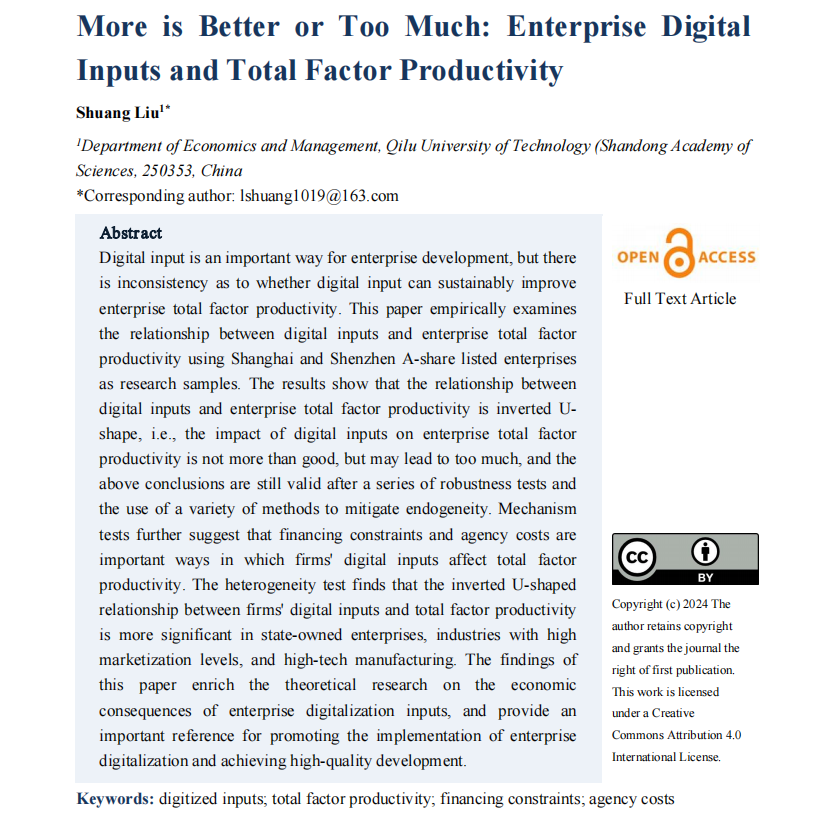More is Better or Too Much: Enterprise Digital Inputs and Total Factor Productivity
DOI:
https://doi.org/10.5281/zenodo.14550163Keywords:
digitized inputs, total factor productivity, financing constraints, agency costsAbstract
Digital input is an important way for enterprise development, but there is inconsistency as to whether digital input can sustainably improve enterprise total factor productivity. This paper empirically examines the relationship between digital inputs and enterprise total factor productivity using Shanghai and Shenzhen A-share listed enterprises as research samples. The results show that the relationship between digital inputs and enterprise total factor productivity is inverted U-shape, i.e., the impact of digital inputs on enterprise total factor productivity is not more than good, but may lead to too much, and the above conclusions are still valid after a series of robustness tests and the use of a variety of methods to mitigate endogeneity. Mechanism tests further suggest that financing constraints and agency costs are important ways in which firms' digital inputs affect total factor productivity. The heterogeneity test finds that the inverted U-shaped relationship between firms' digital inputs and total factor productivity is more significant in state-owned enterprises, industries with high marketization levels, and high-tech manufacturing. The findings of this paper enrich the theoretical research on the economic consequences of enterprise digitalization inputs, and provide an important reference for promoting the implementation of enterprise digitalization and achieving high-quality development.
References
[1] Guo, X., Li, M., Wang, Y., & Mardani, A. (2023). Does digital transformation improve the firm’s performance? From the perspective of digitalization paradox and managerial myopia. Journal of Business Research, 163, 113868.
[2] Ma, S., & Li, C. X. (2020). Research on Digital Transformation of Old Firms Based on the Perspective of Paradox Management--The Case of Zhangbao Liquor Industry. China Soft Science, (04), 184-192.
[3] Sun, Z., Zhao, L., Kaur, P., Islam, N., & Dhir, A. (2023). Theorizing the relationship between the digital economy and firm productivity: The idiosyncrasies of firm-specific contexts. Technological Forecasting and Social Change, 189, 122329.
[4] Sousa-Zomer, T. T., Neely, A., & Martinez, V. (2020). Digital transforming capability and performance: a microfoundational perspective. International Journal of Operations & Production Management, 40(7/8), 1095-1128.
[5] Khin, S., & Ho, T. C. (2019). Digital technology, digital capability and organizational performance: A mediating role of digital innovation. International Journal of Innovation Science, 11(2), 177-195.
[6] Peng, Y., & Tao, C. (2022). Can digital transformation promote enterprise performance?—From the perspective of public policy and innovation. Journal of Innovation & Knowledge, 7(3), 100198.
[7] Blichfeldt, H., & Faullant, R. (2021). Performance effects of digital technology adoption and product & service innovation–A process-industry perspective. Technovation, 105, 102275.
[8] Gao, S., Li, W., Meng, J., Shi, J., & Zhu, J. (2023). A study on the impact mechanism of digitalization on corporate green innovation. Sustainability, 15(8), 6407.
[9] Hao, X., Li, Y., Ren, S., Wu, H., & Hao, Y. (2023). The role of digitalization on green economic growth: Does industrial structure optimization and green innovation matter?. Journal of environmental management, 325, 116504.
[10] Proksch, D., Rosin, A. F., Stubner, S., & Pinkwart, A. (2024). The influence of a digital strategy on the digitalization of new ventures: The mediating effect of digital capabilities and a digital culture. Journal of small business management, 62(1), 1-29.
[11] Wang, L. (2023). Digital transformation and total factor productivity. Finance Research Letters, 58, 104338.
[12] Chang, C. C., & Tang, H. W. (2021). Corporate cash holdings and total factor productivity–A global analysis. The North American Journal of Economics and Finance, 55, 101316.
[13] Lee, C. C., & Lee, C. C. (2022). How does green finance affect green total factor productivity? Evidence from China. Energy economics, 107, 105863.
[14] Ma, Y., Ni, H., Yang, X., Kong, L., & Liu, C. (2023). Government subsidies and total factor productivity of enterprises: a life cycle perspective. Economia Politica, 40(1), 153-188.
[15] Ren, X., Zhang, X., Yan, C., & Gozgor, G. (2022). Climate policy uncertainty and firm-level total factor productivity: Evidence from China. Energy Economics, 113, 106209.
[16] Bach, M. P., Spremić, M., & Vugec, D. S. (2018). Integrating digital transformation strategies into firms: Values, routes and best practice examples. In Management and Technological Challenges in the Digital Age (pp. 107-128). CRC Press.
[17] Chen, W., & Kamal, F. (2016). The impact of information and communication technology adoption on multinational firm boundary decisions. Journal of International Business Studies, 47, 563-576.
[18] Feng, S., Chong, Y., Yang, Y., & Hao, X. (2022). Digitization and total factor productivity: evidence from China. The Singapore Economic Review, 1-33.
[19] Chinoracky, R., & Corejova, T. (2021). How to evaluate the digital economy scale and potential?. Entrepreneurship and Sustainability Issues, 8(4), 536.
[20] Liu, S. C., Yan, J. C., Zhang, S. X., & Lin, H. C. (2021). Can digital change in business management improve input-output efficiency. Management World (05), 170-190+13.
[21] Lee, C. C., & Ho, S. J. (2022). Impacts of export diversification on energy intensity, renewable energy, and waste energy in 121 countries: Do environmental regulations matter?. Renewable Energy, 199, 1510-1522.
[22] Acemoglu, D., Antràs, P., & Helpman, E. (2007). Contracts and technology adoption. American Economic Review, 97(3), 916-943.
[23] Wen, H., Wen, C., & Lee, C. C. (2022). Impact of digitalization and environmental regulation on total factor productivity. Information Economics and Policy, 61, 101007.
[24] Huang, B., Li, H. T., Liu, J. Q., & Lei, J. H. (2023). Digital technology innovation and high-quality development of Chinese firms - Evidence from firms' digital patents. Economic Research (03), 97-115.
[25] Yu, L. P., Zhang, K. W., & Wu, K. H. (2024). Research on the mechanism of digital transformation on enterprise innovation: based on the perspective of technological innovation and management innovation. China Soft Science (01), 24-35.
[26] Chen, N., Sun, D., & Chen, J. (2022). Digital transformation, labour share, and industrial heterogeneity. Journal of Innovation & Knowledge, 7(2), 100173.
[27] Gao, X., & Feng, H. (2023). AI-driven productivity gains: Artificial intelligence and firm productivity. Sustainability, 15(11), 8934.
[28] Tang, L. M. (2022). Digital transformation and technological innovation of enterprises: the formation mechanism of inverted U-shaped relationship and its test. Modern Economic Discussion (12), 91-102.
[29] Yu, F. F., Cao, J. Y., & Du, H. Y. (2022). The digital paradox: The double-edged sword effect of corporate digitalization on innovation performance. Research and Development Management (02), 1-12.
[30] Karhade, P., & Dong, J. Q. (2021). Information technology investment and commercialized innovation performance: Dynamic adjustment costs and curvilinear impacts. Mis Quarterly, 45(3), 1007-1024.
[31] Gebauer, H., Fleisch, E., Lamprecht, C., & Wortmann, F. (2020). Growth paths for overcoming the digitalization paradox. Business Horizons, 63(3), 313-323.
[32] Pang, R. Z., & Liu, Dong. G. (2022). The paradox of digitization and innovation: does digitization promote corporate innovation - an explanation based on open innovation theory. Southern Economy (09), 97-117.
[33] Li, F., Nucciarelli, A., Roden, S., & Graham, G. (2016). How smart cities transform operations models: A new research agenda for operations management in the digital economy. Production Planning & Control, 27(6), 514-528.
[34] Levinsohn, J., & Petrin, A. (2003). Estimating production functions using inputs to control for unobservables. The review of economic studies, 70(2), 317-341.
[35] Li, C., Huo, P., Wang, Z., Zhang, W., Liang, F., & Mardani, A. (2023). Digitalization generates equality? Enterprises’ digital transformation, financing constraints, and labor share in China. Journal of Business Research, 163, 113924.
[36] Kehrig, M., & Vincent, N. (2021). The micro-level anatomy of the labor share decline. The Quarterly Journal of Economics, 136(2), 1031-1087.
[37] Gull, A. A., Atif, M., Ahsan, T., & Derouiche, I. (2022). Does waste management affect firm performance? International evidence. Economic Modelling, 114, 105932.
[38] Levine, O., & Warusawitharana, M. (2021). Finance and productivity growth: Firm-level evidence. Journal of Monetary Economics, 117, 91-107.
[39] Zhang, X., Li, J., Xiang, D., & Worthington, A. C. (2023). Digitalization, financial inclusion, and small and medium-sized enterprise financing: Evidence from China. Economic Modelling, 126, 106410.
[40] Tian, G., Li, B., & Cheng, Y. (2022). Does digital transformation matter for corporate risk-taking?. Finance Research Letters, 49, 103107.
[41] Tuan, T. M., Nha, P. V. T., & Phuong, T. T. (2019). Impact of agency costs on firm performance: Evidence from Vietnam. Organizations and Markets in Emerging Economies, 10(2), 294-309.
[42] Sun, X. J., Zhai, S. P., & Yu, S. (2019). Can flexible tax administration alleviate corporate financing constraints - Evidence from a natural experiment on tax credit rating disclosure. China Industrial Economy (03), 81-99.
[43] Rashid, A. (2016). Managerial ownership and agency cost: Evidence from Bangladesh. Journal of business ethics, 137, 609-621.
[44] Wang, F. (2024). Corporate ESG Performance and Low-Carbon Green Transition: An Assessment of the Effect of Financial Policy Instruments. Contemporary Finance and Economics (01), 152-164.
[45] Wei, S. W., Du, J. M., & Pan, S. (2022). How the Digital Economy Promotes Green Innovation - Empirical Evidence from Chinese Cities. Journal of Finance and Economics (11), 10-20.

Downloads
Published
How to Cite
Issue
Section
License
Copyright (c) 2024 Shuang Liu

This work is licensed under a Creative Commons Attribution 4.0 International License.


























